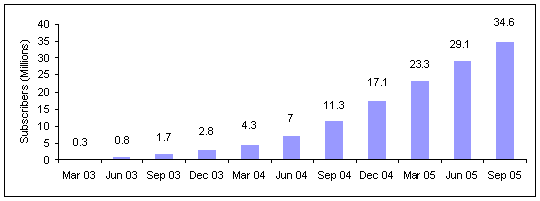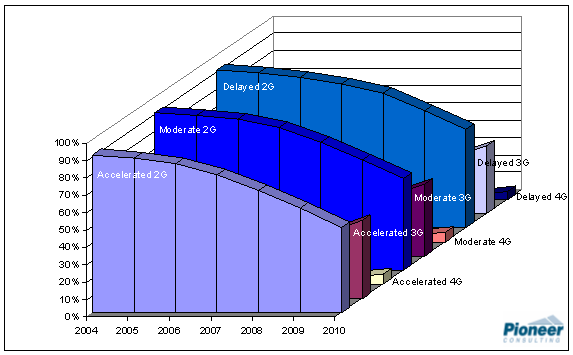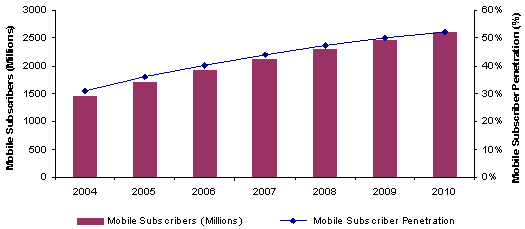|
As a
leading publisher of research on emerging wireless
technologies, Pioneer Consulting has been monitoring
developments in the 4G space. 2G/2.5G is well-entrenched as
the mainstream cellular technology around the world, 3G is
stuttering and struggling to gain market share for a variety
of reasons, and 4G is gaining some credence. This report is
intended to deliver some timely value-adding research to the
general body of knowledge on this area by analysing the
interplay between these three generations of mobile
technology. The ultimate goal is to provide a picture of what
the global mobile telecom market will look like in 2010.
Moreover,
this report asks the questions:
Thus, the
overall purpose of this report is to give the reader some
fresh perspectives on the issue of 4G by looking at this
technology, not as an isolated phenomenon, but as part of an
ongoing technological evolution and to provide some
ground-breaking analysis in terms of average user bandwidth
demand, as well as the usual measurements of subscribers,
penetration rates, installations, and equipment sales.
1.
Technological Comparison
Instead of characterising the evolution of
3G and 4G mobile technologies as some battle to the death
between species, Pioneer believes that there is potential for
complementarity between the various technologies which reside
under the 3G and 4G “umbrellas”.
While there is also some potential for
overlap and confrontation, there are clearly market
applications which suit only one technology e.g. WiMAX as a
backhaul solution for mobile; EV-DO for an “always-on” mobile
service.
Pioneer believes that the ideal outcome
from the parallel evolutions of 3G and 4G should be that the
end user is better served with a choice of technologies and
networks which provides flexibility according to the end
user’s circumstances and needs at any one time. Of course,
realization of this vision will require an agnostic handset!
2.
Comparative Technology Costs
At this stage, no certified 4G network
equipment has been commercialised, so prices are unknown.
However, it is reasonable to expect that an unproven new
technology will, at first, attract low demand, so prices will
be relatively high and will only fall gradually as demand
increases. Due to the initial cost of CPE, 4G operators are
expected to offer leasing agreements.
3. 3G
Market Overview
3.1 Lack
of Demand
The market
penetration of 3G services has been slower than expected,
primarily due to lack of demand for enhanced services, delayed
deployments by the operators and issues related to coverage
and Quality of Service (QoS).
3.2
Other Challenges
Impeded
from the very start by the high entry costs making
profitability elusive, 3G technologies have faced a number of
other challenges including, operating costs which are
significantly higher than in a 2G/2.5G operation and
uncertainty surrounding forecast demand for non-voice
features.
Exhibit
1: Worldwide Growth of 3G UMTS Subscribers

Source: 3G Today
4. 4G
Market Overview
4.1
Demand for High-Speed Multimedia Services
The demand for sophisticated multimedia
services has increased significantly in recent times. To be
sustainable, this kind of demand growth will require the
support of higher-capacity networks.
4.2 Fixed-Mobile Convergence
Users are looking for ‘always on, always
connected’ solutions and expect bundled solutions for their
fixed and mobile service requirements. FMC would enable an
operator to provide both fixed as well as mobile services by
using the same network infrastructure.
4.3
Spectrum Issues
None of the
licensed frequency bands are available in all key markets,
making global alignment of the frequency band for WiMAX
currently impossible. Governments are moving to rationalise
spectrum usage but the advent of 4G wireless technologies will
likely occur incrementally rather than in the form of a
paradigm shift.
4.4
Standards & Certification Issues
The first
fixed WiMAX products meeting the requirements of 802.16d have
been certified but the equipment certification process, which
is essential for commercialisation, will likely continue at
least until the end of 2006. Furthermore, the mobile version
of the WiMAX standard (802.16e) has been approved but
certified products will only be available in 2007 at the
earliest.
4.5
Technological Challenges
As with any
new technology, certain technical challenges need to be
resolved before WiMAX and other 4G technologies can be adopted
on a large scale.
4.6
Alternative Applications for 4G
Fixed WiMAX
is being used to provide last mile access in remote or rural
areas or to provide high-speed data services to enterprises.
Operators are also looking at fixed WiMAX as a Wi-Fi backhaul
solution.
5.
Prospects for Future Deployment of 3G and 4G
5.1
Market Share Forecasts
Pioneer
believes that 4G mobile technology will stimulate subscriber
interest in broadband wireless applications but the lack of 4G
availability, and the cost of a 4G mobile phone, will lead
many 2G users to settle for an upgrade to 3G.
Exhibit
2: Comparison of Forecast 2G, 3G, & 4G Penetration Rates in
Asia Pacific across Scenarios

Furthermore, operators, particularly those who are heavily
invested in 3G, will seek to use 4G technologies to augment
their network and the services they can offer, rather than
replace their existing networks.
5.2
Manufacturer Strategies
Manufacturers are initially targeting the fixed WiMAX market,
with a focus on CPE as well as base stations. With increasing
consumer demand for services offering enhanced mobility,
several of the major network equipment providers are actively
promoting the 802.16e standard as they see a bigger
opportunity in mobile WiMAX.
5.3
Network Operator Strategies
Incumbents
are using 4G technology to make their coverage more
comprehensive, WISPs are using WiMAX to provide broadband
wireless services, wireline operators plan to enter the mobile
telephony segment and start-ups are looking to challenge the
incumbents using WiMAX as the vehicle. Regional differences
are discussed in detail in the report.
5.4
Global Spectrum Harmonisation
Since the
2.5 GHz band has been reserved for implementation of 3G
technologies within the IMT-2000 family, the WiMAX Forum is
lobbying for WiMAX to be classified as an IMT-2000 technology.
The Forum is also trying to investigate if WiMAX could share
frequency bands with UMTS but 3G operators are offering
resistance. Neither of these initiatives seems likely to bear
fruit in the near term.
6.
Forecasts
6.1
Mobile Markets
Between
2005 and 2010, the total mobile subscriber base in North
America, Europe and Asia Pacific, is expected to grow at a
CAGR of 8.8% from 1.7 billion to 2.6 billion subscribers.
Annual subscriber growth in North America and Europe will
decline gradually as markets become saturated, but the Asia
Pacific region will see accelerated growth (see Exhibit 3).
Exhibit
3: Forecast Combined Mobile Subscriber Population in
North America, Europe, & Asia Pacific 2004-10

With strong
annual subscriber growth forecast in Asia Pacific, the demand
for BTS is also expected to increase until 2008. However, the
more saturated markets of Europe and North America are
expected to show a decline in the number of annual BTS
deployments throughout the forecast period.
6.2
Demand for 2G, 3G, & 4G (Fixed & Mobile)
Exhibit 4 summarises the forecast demand data
which is provided in this report for fixed WiMAX in wireless
backhaul for the mobile market, and for mobile WiMAX.
Exhibit 4:
Forecast Data Available from this Report
|
SCENARIO A:
ACCELERATED 3G/4G PENETRATION |
Regions |
Technologies |
|
Markets |
Parameter |
North America |
Europe |
Asia Pacific |
2G |
3G |
4G |
|
Both |
Penetration (%) |
X |
X |
X |
X |
X |
X |
|
Subscribers (Millions) |
X |
X |
X |
X |
X |
X |
|
Wireless Backhaul |
WiMAX BTS Installations (000’s) |
X |
X |
X |
|
|
|
|
WiMAX Equipment Sales ($) |
X |
X |
X |
|
|
|
|
Mobile |
Bandwidth Demand (Gb/s) |
X |
X |
X |
X |
X |
X |
|
SCENARIO B:
MODERATE 3G/4G PENETRATION |
Regions |
Technologies |
|
Markets |
Parameter |
North America |
Europe |
Asia Pacific |
2G |
3G |
4G |
|
Both |
Penetration (%) |
X |
X |
X |
X |
X |
X |
|
Subscribers (Millions) |
X |
X |
X |
X |
X |
X |
|
Wireless Backhaul |
WiMAX BTS Installations (000’s) |
X |
X |
X |
|
|
|
|
WiMAX Equipment Sales ($) |
X |
X |
X |
|
|
|
|
Mobile |
Bandwidth Demand (Gb/s) |
X |
X |
X |
X |
X |
X |
|
SCENARIO C:
DELAYED 3G/4G PENETRATION |
Regions |
Technologies |
|
Markets |
Parameter |
North America |
Europe |
Asia Pacific |
2G |
3G |
4G |
|
Both |
Penetration (%) |
X |
X |
X |
X |
X |
X |
|
Subscribers (Millions) |
X |
X |
X |
X |
X |
X |
|
Wireless Backhaul |
WiMAX BTS Installations (000’s) |
X |
X |
X |
|
|
|
|
WiMAX Equipment Sales ($) |
X |
X |
X |
|
|
|
|
Mobile |
Bandwidth Demand (Gb/s) |
X |
X |
X |
X |
X |
X |
Source: Pioneer Consulting
|